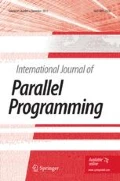Abstract
This paper uses elementary algebraic methods to obtain new proofs for theorems on algebraic relationships between the logarithmic and exponential functions. The main result is a multivariate version of a special case of the structure theorem due to Risch that gives, in a very explicit fashion, the possible algebraic relationships between the exponential and logarithm functions. The structure theorem has important applications to symbolic mathematical computation in that it in essence provides a canonical form for the elementary transcendental functions, and hence solves the identity problem for this class of functions. Such applications are discussed in the last section.
Similar content being viewed by others
References
James Ax, “On Schanuel's conjectures,”Ann. Math. 93:252–568 (1971).
W. S. Brown, “Rational exponential expressions and a conjecture concerning π ande,”Am. Math. Mon. 76:28–34 (January 1969).
B. F. Caviness, “On canonical forms and simplification,”J. Ass. Comput. Mach. 17:385–396 (April 1970).
B. F. Caviness and Michael Rothstein, “A Liouville theorem on integration in finite terms for line integrals,”Commun. Alg. 3:781–795 (1975).
G. E. Collins, “The SAC-1 System: An Introduction and Survey,”Proc. Second Symposium on Symbolic and Algebraic Manipulation, S. R. Petrick, ed. (Association for Computing Machinery, New York, 1971), pp. 144–152.
H. I. Epstein, “Algorithms for Elementary Transcendental Function Arithmetic,” Ph.D. thesis, University of Wisconsin, Madison, Wisconsin (April 1975), 409 pp. (Available from University Microfilms International, Ann Arbor, Michigan).
R. J. Fateman, “Essays in Algebraic Simplification,” Project MAC TR-95, Massachusetts Institute of Technology, Cambridge, Mass. (April 1972).
J. P. Fitch, “On algebraic simplification,”Comput. J. 18:23–27 (February 1973).
J. H. Griesmer and R. D. Jenks, “SCRATCHPAD/1-An Interactive Facility for Symbolic Mathematics,”Proc. Second Symposium on Symbolic and Algebraic Manipulation, S. R. Petrick, ed. (Association for Computing Machinery, New York, 1971), pp. 42–58.
A. D. Hall Jr., “The Altran System for Rational Function Manipulation-A Survey,Proc. Second Symposium on Symbolic and Algebraic Manipulation, S. R. Petrick, ed. (Association for Computing Machinery, New York, 1971).
G. H. Hardy,The Integration of Functions of a Single Variable, 2nd Ed. (Cambridge University Press, London, 1928).
A. C. Hearn, “REDUCE-2: A System and Language for Algebraic Manipulation,”Proc. Second Symposium on Symbolic and Algebraic Manipulation, S. R. Petrick, ed. (Association for Computing Machinery, New York, 1971), pp. 128–133.
S. C. Johnson, “On the problem of recognizing zero,”J. Assoc. Comput. Mach. 18:559–565 (October 1971).
Irving Kaplansky,An Introduction to Differential Algebra (Hermann, Paris, 1957).
E. R. Kolchin, “Algebraic groups and algebraic dependence,”Am. J. Math. 90:1151–1164 (1968).
E. R. Kolchin,Differential Algebra and Algebraic Groups (Academic Press, New York, 1973).
Joseph Liouville, “Sur la détermination des integrales dont la valeur est algébrique,” J. ÉcolePolytech. 14 (Sect. 23):124–193 (1833).
Joseph Liouville, “Mémoire sur les transcendantes élliptiques de première et de seconde espèce, considérées comme fonctions de leur amplitude,”J. École Polytech. 14 (Sect. 24):57–83 (1833).
Joseph Liouville, “Mémoire sur l'intégration d'une classe de fonctions transcendantes,”J. Reine Angew. Math. 13:93–118 (1835).
Joseph Liouville, “Mémoire sur la classification des transcendantes et sur l'impossibilité d'exprimer les racines de certain équations en fonction finie explicite des coefficients,”J. Math. Pures Appl. 2:56–104 (1837);3:523–546 (1838).
Joseph Liouville, Mémoire sur l'intégration d'une classe d'équations différentielles du second ordre en quantités finies explicites,”J. Math. Pures Appl. 4:423–456 (1839).
Joseph Liouville, “Mémoire sur les transcendantes élliptiques de première et de seconde espèce, considérées comme fonction de leur module,”J. Math. Pures Appl. 5:34–36, 441–464 (1840).
Joseph Liouville, “Remarques nouvelles sur l'équation de Riccati,”J. Math. Pures Appl. 6:1–13 (1841).
W. A. Martin and R. J. Fateman, “The MACSYMA System,”Proc. Second Symposium on Symbolic and Algebraic Manipulation, S. R. Petrick, ed. (Association for Computing Machinery, New York, 1971), pp. 59–75.
Joel Moses, “Algebraic simplification: a guide for the perplexed,”Commun. ACM 14:527–537 (August 1971).
Joel Moses, “Toward a general theory of special functions,”Commun. ACM 15:550–554 (July 1972).
Alexandre Ostrowski, “Sur les relations algébriques entre les intégrales indéfines,”Acta Math. 78:315–318 (1946).
Daniel Richardson. “Some unsolvable problems involving elementary functions of a real variable,”J. Symb. Logic 33:514–520 (1968).
Daniel Richardson, “A solution of the identity problem for integral exponential functions,”Z. Math. Logik Grundlagen Math. 15:333–340 (1969).
Daniel Richardson, “The simple exponential constant problem,”Z. Math. Logik Grundlagen Math. 17:133–136 (1971).
R. H. Risch, “Further Results on Elementary Functions,” IBM Technical Report RC 2402, Yorktown Heights, New York (March 1969).
R. H. Risch, “The problem of integration in finite terms,”Trans. Am. Math. Soc. 139:167–189 (May 1969).
R. H. Risch, “The solution of the problem of integration in finite terms,”Bull. Am. Math. Soc. 76:605–608 (May 1970).
R. H. Risch, “Algebraic Properties of the Elementary Functions of Analysis,” IBM Technical Report RC 5565, Yorktown Heights, New York (August 1975).
J. F. Ritt,Integration in Finite Terms: Liouville's Theory of Elementary Methods (Columbia University Press, New York, 1948).
J. F. Ritt,Differential Algebra (American Mathematical Society, Providence, Rhode Island, 1950); republished by Dover Publications, Inc., New York, 1966.
Maxwell Rosenlicht, “Liouville's theorem on functions with elementary integrals,”Pacific J. Math. 24:153–161 (1968).
Maxwell Rosenlicht, “Integration in finite terms,”Am. Math. Mon. 79:963–972 (November 1972).
Maxwell Rosenlicht, “On theory of elementary functions” (preprint).
Author information
Authors and Affiliations
Additional information
This research was supported in part by National Science Foundation Grants GJ-30125X and MCS76-23762.
Rights and permissions
About this article
Cite this article
Epstein, H.I., Caviness, B.F. A structure theorem for the elementary functions and its application to the identity problem. International Journal of Computer and Information Sciences 8, 9–37 (1979). https://doi.org/10.1007/BF00995426
Received:
Revised:
Issue Date:
DOI: https://doi.org/10.1007/BF00995426



